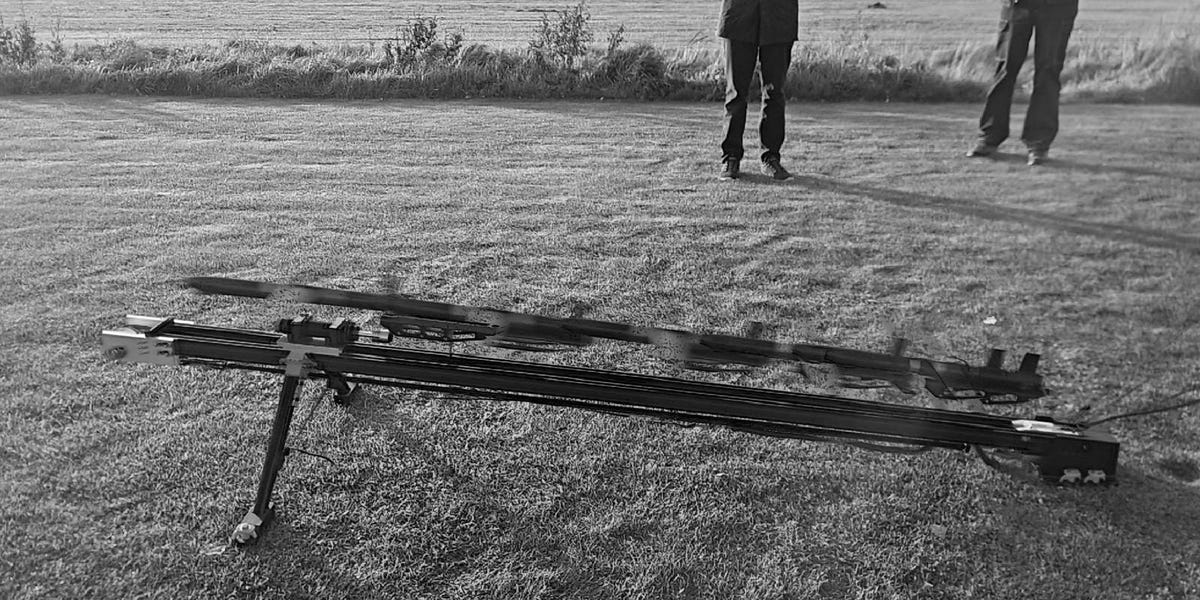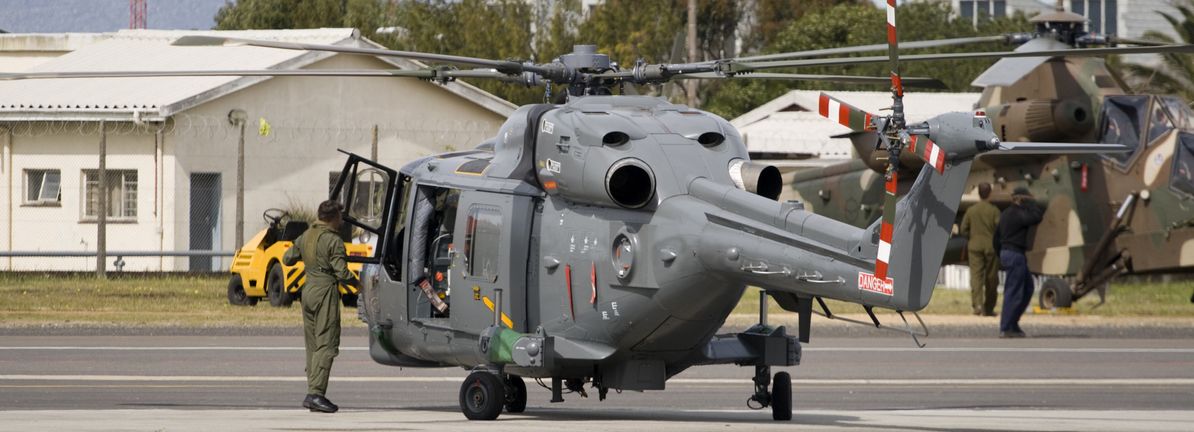Sleek, black, and sporting foldable wings, the footlong Kreuger-100XR looks almost like something you’d find in a toy store aisle.
The rocket-shaped device is what a new Swedish startup hopes will be the future of point air defense against drones.
The Kreuger-100XR, with XR standing for Extended Range, is Nordic Air Defence’s debut product. It’s a mostly carbon fiber interceptor that weighs about a pound and is meant to be deployed in large numbers as an inexpensive, no-frills way to hunt down and destroy uncrewed aerial systems.
European authorities are taking notice. NAD is barely two years old, but was one of four finalists selected this year to compete in a counter-drone contest held in Portugal by Frontex, the European Border and Coast Guard Agency.
Nordic Air Defence.
Startups like NAD are one of the many ways Europe is rebalancing to face Russia’s ability to mass-produce long-range attack drones. They’ll compete with leading contractors that have long dominated the market, such as the French-headquartered MBDA, which is making its own eight-motor interceptors to be rolled out at scale.
The startups have an edge up their sleeve. Defense primes, though more established and better connected, typically charge a premium and are often seen as large, cumbersome organizations. NAD has about two dozen employees, while MBDA and US-headquartered Lockheed Martin, for example, have 18,000 and 121,000, respectively.
Fastest in class, NAD says
NAD says the Kreuger-100XR’s propeller can push the craft to speeds above 220 mph, and that its optimal range is about two miles at an altitude of around 3,300 feet.
That distance is relatively short for typical air defense, but NAD is banking on low cost as a selling point.
The firm declined to disclose the exact price of the interceptor, saying it costs a few thousand dollars each. Traditional short-range intercept missiles, by comparison, can typically cost anywhere from $400,000 to millions of dollars each; the shoulder-fired Stinger, for example, costs $480,000.
Nordic Air Defence
Jens Holzapfel, NAD’s director of business development, told Business Insider at the company’s Stockholm office that the interceptor is designed with simplicity in mind.
A police officer should be able to easily carry several Kreuger-100XRs in a backpack and then launch them from a handheld device.
“In testing, we can either throw it like a dart or use a catapult,” Holzapfel said, balancing a prototype on his fingers.
He added that only someone with an exceptionally strong arm can hurl the interceptor fast enough for an effective launch.
Making cheap counters to drone swarms
Holzapfel said the Kreuger-100XR’s main cost goes toward two key components. The first is a camera that enables the interceptor to autonomously acquire its target, while the second is an optional 250-gram explosive warhead for destroying larger aircraft such as the Shahed-136 attack drone.
A cheaper version with a laser seeker, in lieu of a camera, is also planned. It will require a laser designator, whether operated by a human or an autonomous device, to track its target.
“With the XR, its wings also allow us to loiter, so we don’t need a straight-shot scenario,” Holzapfel said. With a radio connection, the interceptor is designed to remain airborne for at least 20 minutes before acquiring a target.
Nordic Air Defence
In that sense, the Kreuger-100XR can act like an autonomous drone — and that’s NAD’s long-term vision. A cheap, fire-and-forget interceptor could become a fundamental defense against enemy drone swarms, an anticipated threat for which militaries around the world are preparing.
“The economy of war is at such a point that it’s about scalability,” Holzapfel said. “If we are being attacked by a swarm of drones, we need a swarm of counter-drones.”
Ukrainian drone manufacturers have also been developing their own interceptors: quadcopters capable of flying fast enough to catch the Shahed.
“But they tend to be slower or more expensive,” Holzapfel said.
While many interceptor drones use four motors, which can be more costly, the Kreuger-100XR uses a single prop engine, helping NAD drive down costs and increase the device’s speed, he said.
Matthew Loh/Business Insider
Yet it may be some time until a Kreuger-100XR counterswarm becomes a reality. Holzapfel said NAD is still working on friend-or-foe programming to prevent multiple interceptors from targeting each other.
Shaheds and recon drones
The firm is positioning the Kreuger-100XR to fight the Shahed, which Russia has been using in droves to bombard Ukrainian cities and overwhelm air defenses.
Kyiv also needs more defensive options against unjammable, small drones that use cable connections, as well as medium-range reconnaissance drones like the Orlan.
NAD plans to conduct trials in Ukraine soon, but has yet to test its product in battle. An operational altitude of 1,000 meters will also be a challenge for the Kreuger-100XR, because many Russian Shaheds and Gerbera decoys are known to cruise at 2,000 meters or above before diving down at their targets.
Ukrainian President Volodymyr Zelenskyy/Screengrab via X
But Holzapfel said the Kreuger-100XR’s “fastest-in-class” speed of 220 mph can still give it an edge against the Shahed-136, which typically flies at speeds around 115 mph.
“We are aiming toward the Shahed scenario for sure,” he said. “And that’s why we’re also considering the air trail scenario, where we’ll be chasing Shaheds from another airborne platform and attack them even from above.”
Or the Kreuger-100XR could intercept the drones during their terminal attack, though it would be harder to accurately strike the Russian drone in that scenario because of their higher speeds.
To build an interceptor
Holzapfel said NAD is completing its prototyping phase and moving toward mass production. Although most of the Kreuger-100XR’s manufacturing should be automated — particularly for the fuselage and wings — it will still require humans for some assembly tasks, such as mounting the explosive warhead.
NAD aims to establish initial manufacturing operations in Sweden, but anticipates that it may be asked to build the Kreuger-100XR on-site for foreign clients.
“If we’re in Britain, they probably want to have Brits assembling these,” Holzapfel said.
The startup is planning for its supply chain to have as little dependence on China as possible, sourcing off-the-shelf components from manufacturers in Europe, North America, Japan, or South Korea.
For now, NAD makes its interceptors on the ninth floor of an office building in Stockholm, where its team of 23 sits among a mix of 3D printers, prototypes, and workshop tables.
Nestled in the corner of a room is one of the startup’s test-launch catapults: a few metal poles and some string.
Matthew Loh/Business Insider
After its founding in March 2024, NAD initially worked on another interceptor. The Kreuger-100XR’s predecessor, the Kreuger-100, is a propeller-driven, wingless device designed to eliminate drones solely by hitting them in flight.
However, it’s ideally suited for smaller, commercial drones, such as the hobby drones that Ukrainian and Russian troops face regularly on the front lines today.
Matthew Loh/Business Insider
Holzapfel said prospective clients were more interested in capabilities for fighting larger targets, such as Shaheds, and so the firm pivoted toward the XR variant during the summer.
So far, NAD has raised about $4.4 million and is looking to begin another seed round early next year, he added. Afterward, the firm hopes to recruit software engineers to train artificial intelligence that can manage a defensive swarm.
Despite pressure in the industry for startups to send their products to Ukraine as soon as possible, Holzapfel said NAD is waiting until it’s sure that the Kreuger-100XR can deliver.
“Everyone is saying: ‘You’ve got to be in Ukraine, you’ve got to be in Ukraine.’ But we don’t want to just be tourists and waste anybody’s time,” he said. “We weren’t going to be there until we were really confident in our product.”









